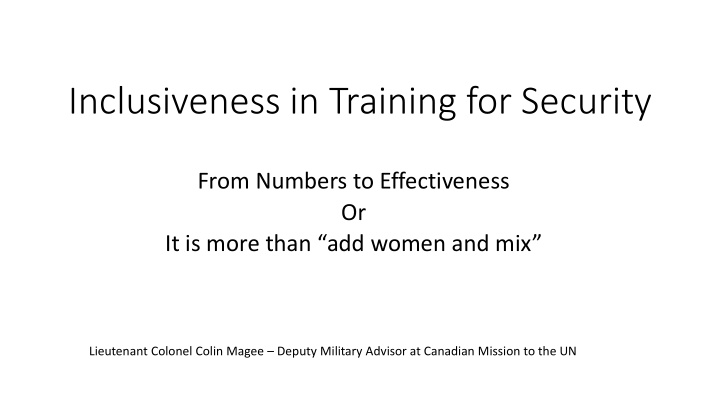



Inclusiveness in Training for Security From Numbers to Effectiveness Or It is more than “add women and mix” Lieutenant Colonel Colin Magee – Deputy Military Advisor at Canadian Mission to the UN
Diversity Matters for UN Peacekeeping Operati ons • Increases operational effectiveness • More diversity means: • Greater views of what the problem is; • Greater range of solutions to solve or mitigate the problem; • Greater choice in individuals who can execute the task. • Diversity of Gender: • UNSCR 1325 • National Action Plans for 1325; • UN Gender parity strategy; • UN Engagement Platoon; • ELSIE – • Barrier Assessment; • Gender Strong Units - substantial representation of women across all functions of a unit, including command positions; and • ELSIE Fund.
Why the Engagement Platoon 1. Lack of engagement with the local population; 2. A lack of sophisticated protection of civilian strategies and poor Early Warning Mechanisms; 3. Increase the Battalion’s situational awareness within its area; 3. To broaden engagement activities – specifically to understand the threats faced by vulnerable members of communities.
Engagement Platoon for UN Peace Operations • An EP is to be established in each Inf Bn. • The EP will be embedded within the Battalion’s Combat Support Company. • The EP is to have an Officer in Charge, along with a 2IC. • The Platoon will be made up of a number of engagement teams (ET), containing four personnel per team. • Battalions with three companies will have four ETs in the Engagement Platoon. • Battalions with four companies will have five ETs. • The EPs are to be at least 50 per cent women. TCCs may choose to establish teams with more than 50 per cent women. • The teams can be made up of men and women from any branch of the military and any rank • EPs are optional in specialist Inf Bns, such as a Quick Response Force or Special Forces Battalion as these Battalions are designed for offensive actions rather than engagement
Mission • The mission of the EP is to enhance the situational awareness of the battalion by engaging with the local population and mapping the human terrain of the AO in order to identify vulnerable areas and at- risk populations. • Outcome - enhance situational awareness • Focusing on - identifying vulnerable areas and at-risk populations • How - engaging with the local population - mapping the human terrain.
Tasks of f the Engagement Platoon • Provide information to the Military Peacekeeping Intelligence section. • Identify the vulnerabilities, needs and interests of local men, women, boys and girls. • Conduct gender perspective-inclusive Village Assessments, as outlined in Annex C to the UNIBAM, to improve situational awareness. • Undertake patrol activities, including repeat engagement, to foster trust with local population. • Engage in dialogue with local communities to better understand their situation and unique needs, including protection and prevention strategies. Specifically, EPs should focus on CRSV, Human Trafficking, crimes against Children and other breaches of humanitarian law. • Establish and maintain liaison with civil actors to facilitate cooperation, information sharing and better planning and conduct of operations. • Facilitate military operations by creating and sustaining conditions to achieve mission objectives. • Continuously monitor and report on the Operating Environment. • Work with Community Liaison Assistants (CLA) to conduct targeted patrolling and related activities.
Potential Barriers to Women’s Participation to Engagement Platoon 1. eligible pool; 1. employment criteria of non-infantry; 2. deployment selection; 2. lack of understanding of how to 3. deployment criteria; employ engagement platoon; 4. household constraints; 3. “competing” organisations; 5. peace operations infrastructure, 4. attitude of members of infantry unit; 6. negative experiences , 5. ”loss” of infantry positions; 7. redeployment incentives, 6. potential training time: 8. top-down leadership, a. basic land skills; 9. gender roles b. engagement platoon specialty. 10. social exclusion .
Increasing Diversity - Multiple Lines of Effort accepting the importance of women in all aspects of PKO Leadership - Ensuring women are aware of PKO opportunities (national level) There is a leader centric There is a Receptive Environment within the Mission - Number of women in key positions approach to establishing and - Training and education of leaders on maintaining an organisational - This is a leader centric task – ie. not the GENAD culture that understands and There is a culture of acknowledging and - need/value of women accepts the importance of - barriers to the effective employment of women women in PKO - how to ensure a receptive environment. Physical environnent Identify and quantify the differing needs of men and women then meet Personal Wellbeing those needs within operational - physical restraints to allow both to - emotional effectively perform their duties. - mental - equipment Training and Education Men understand the positive - Of men within the mission to shape the operational impact that are culture and environment achieved by having women in all - Operational impact of women roles and ranks within PKO; and - GBA+ understand their role in - SEA/Harassment sustaining a receptive environment - For women to provide training needed to perform non-traditional roles Women are provided the - Filling national gaps in training required knowledge, skills and - Basic field training for non-army attributes to perform duties - Staff officer training across all areas within PKO Notes 1. each aspect needs to be examined through separate lens of military – UNMO, Staff Officer, member of contingent. 2. Barriers as well as enablers for each need to be identified and then addressed. Results from the barrier assessment will allow for member state specific refinement of the outline above. 3. Solutions will likely be multi-dimensional across DOTMLPF or PRICIE. 4. Key enabler/obstacle is leadership
Recommend
More recommend